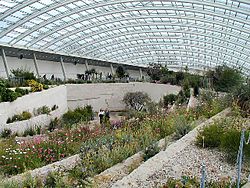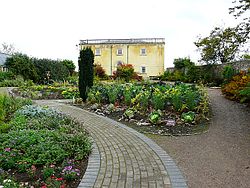- National Botanic Garden of Wales
-
Coordinates: 51°50′31″N 4°08′49″W / 51.842°N -4.147°E
The National Botanic Garden of Wales (NBGW) is situated near Llanarthney in the Towy Valley, Carmarthenshire, Wales. The garden is both a visitor attraction and a centre for botanical research and conservation, and features the world's largest single-span glasshouse measuring 110 m (360 ft) long by 60 m (200 ft) wide.[1]
NBGW seeks "to develop a viable world-class national botanic garden dedicated to the research and conservation of biodiversity and its sustainable utilisation, to lifelong learning and to the enjoyment of the visitor." NBGW is a Registered Charity reliant upon funding from visitors, friends, grants and gifts. From 2008-2009 onwards, the garden will be receiving £550,000 revenue support per annum from the Welsh Assembly Government. Significant start-up costs were shared with the UK Millennium Fund.
Contents
History of the site
The Middleton family from Oswestry built a mansion here in the early 17th century. In 1789 Sir William Paxton bought the estate for £40,000 to create a water park. He used his great wealth to employ some of the finest creative minds of his day, including the eminent architect Samuel Pepys Cockerell, whom he commissioned to design and build a new Middleton Hall, turning the original one into a farm. The new Middleton Hall became ‘one of the most splendid mansions in South Wales’ which ‘far eclipsed the proudest of the Cambrian mansions in Asiatic pomp and splendour’.[2]
Paxton created an ingenious water park. Water flowed around the estate via a system of interconnecting lakes, ponds and streams linked by a network of dams, water sluices, bridges and cascades. Spring water was stored in elevated reservoirs that fed into a lead cistern on the mansion’s roof, allowing Paxton’s residence to enjoy piped running water and the very latest luxury, water closets.[2]
In 1806, Saxton engaged Pepys Cockerell again to design and then over see the construction of Paxton's Tower on the estate, which was completed in 1809. A Neo-Gothic folly erected in honour of Lord Nelson, it is situated on a hilltop near Llanarthney in the Towy Valley. Today the folly is now owned by the National Trust.
By the time of Paxton's death in 1824, Middleton Hall estate covered some 2,650 acres (1,070 ha). The sale agents engaged that year described the esate thus in their catalogue:[3]
“ Richly ornamented by nature, and greatly improved by art. A beautiful tower erected to the memory of the noble hero the late Lord Nelson, forming a grand and prominent feature in the Property and a Land Mark in the County, opposite to which are the Ruins of Dryslwyn Castle, and the Grongar Hills, With the Tower winding to a great extent, presenting a scenery that may vie with any County. As to local amenities, the Roads are excellent, a good Neighborhood, and Country abounding with highly Picturesque Scenery ” Middleton Hall estate was sold to Jamaican-born West India merchant, Edward Hamlin Adams, for £54,700. Neither a gardener nor a lover of water features, while adding buildings that aided his love of country sports, the bath houses quickly fell into disrepair, and only the gardens immediately visible from the house were maintained.
In 1842 the estate passed into the hands of his eccentric son Edward, who immediately changed his name from Adams into the Welsh form Abadam. Not loving the country or gardens, according to his estate manager Thomas Cooke, Edward was a social nightmare. As his son predeceased him, on his death in 1875 the estate passed to his daughter, who had married into the local Hughes family. In 1919 the estate changed hands again when Major William J. H. Hughes sold it to Colonel William N. Jones.
In 1931, the mansion was completely gutted by fire, leaving only the walls standing, themselves covered in globules of moulten lead from the melted roof. After this the estate fell into decline, and 20 years later the walls of the main house were pulled down. The site was then bought by Carmarthenshire County Council, and leased to young farmers hoping to make their way into an agricultural career.[2]
History of the garden
 View from over the Great Glasshouse at the National Botanic Garden of Wales, towards Paxton's Tower
View from over the Great Glasshouse at the National Botanic Garden of Wales, towards Paxton's Tower
In 1978, interest had been captured by local walkers, who were keen to revive the splendour of what they could see around them. Setting up a fund raising scheme, the little money raised led to the rediscovery of a number of historical features.
The idea for a National Botanic Garden of Wales originated from the Welsh artist, William Wilkins, whose aunt had described to him the ruins of an elaborate water features she had discovered while walking in the local woods at Pont Felin Gat.[2] Under the guidance of the Welsh Historic Gardens Trust, an application was made to the Millennium Commission to fund Britain’s first national botanic garden for 200 years.[2]
Virtually on the site of Cockerell's mansion, the Great Glasshouse now forms the centrepiece. Much of the original water-scape has been restored, and extended by introducing cascades to the western approach to the Glasshouse. The extraordinary original view the east side of the mansion offered over the grounds has been restored, extending as originally to Paxton's Tower in the distance. Many experts have commented that this view gives visitors an ability to see and hence understand something of what the great landscape architects of the end of the eighteenth century understood by the word “Picturesque”.
The Garden was opened to the public for the first time on 24 May 2000, and was officially opened on 21 July by the Prince of Wales.[2] In 2003, the garden ran into serious financial difficulties, and in 2004 it accepted a financial package from the Welsh Assembly Government, Carmarthenshire County Council and the Millennium Commission to secure its future.[4]
The site extends to 568 acres (2.30 km2),[5] and among the garden's rare and threatened plants is the whitebeam Sorbus leyana.[4] 21st Century approaches to recycling and conservation have been used in the design of the centre: biomass recycling is used to provide heating for some of the facilities such as the visitor centre and glasshouses.[6]
Botanical collections
 Inside the Great Glasshouse, designed by Sir Norman Foster
Inside the Great Glasshouse, designed by Sir Norman Foster
Placed virtually on the same site as Paxton's new but now demolished Middleton Hall, the Norman Foster, Baron Foster of Thames Bank designed Great Glasshouse is the largest structure of its kind in the world. The structure is 95 m (312 ft) long and 55 m (180 ft) wide, with a roof containing 785 panes of glass. Housing plants from several Mediterranean climate regions, the plants are divided into sections from Chile, Western Australia, South Africa, California, the Canary Islands and the Mediterranean itself.[1]
The Double Walled Garden has been rebuilt from the ruins, and is being developed to house a wide variety of plants, including a modern interpretation of a kitchen garden in one quarter, and ornamental beds to display the classification and evolution of all flowering plant families in the other three quarters.[7]
In 2007, a new Tropical Glasshouse, designed by Welsh architect John Belle, was opened to continue the classification displays with tropical monocotyledons.[8]
Notes
- ^ a b National Botanic Garden of Wales: Glasshouse Facts and Figures
- ^ a b c d e f National Botanic Garden of Wales: History
- ^ "William Paxton". ammanfordtown.com. http://www.ammanfordtown.com/william_paxton.htm. Retrieved 16 September 2011.
- ^ a b p. 592, The Welsh Academy Encyclopedia of Wales. Cardiff: University of Wales Press 2008.
- ^ National Botanic Garden of Wales: Introduction
- ^ National Botanic Garden of Wales: The Biomass Energy Centre
- ^ National Botanic Garden of Wales: Double Walled Garden
- ^ National Botanic Garden of Wales: Tropical House
See also
- List of gardens in Wales
External links
Categories:- Greenhouses
- Botanical gardens in Wales
- Parks in Wales
- Visitor attractions in Carmarthenshire
- Buildings and structures in Carmarthenshire
Wikimedia Foundation. 2010.


